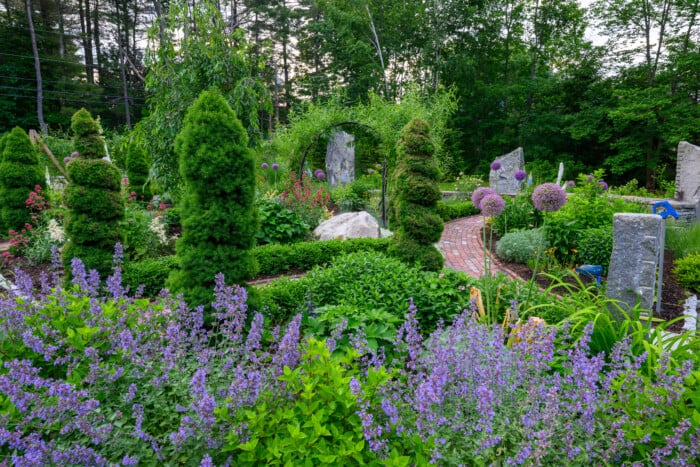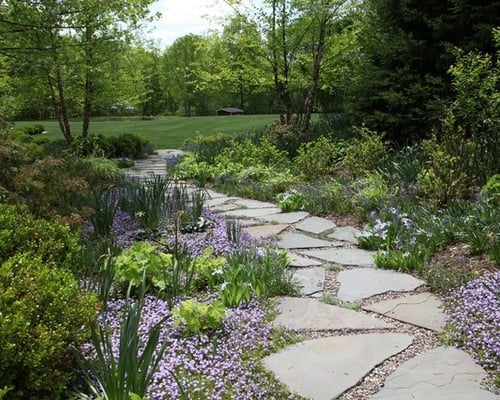Outside the Box(wood) Disaster
After a challenging bout with boxwood blight, Cheri and Stan Fry’s magnificent gardens in Peterborough will once again star in a garden tour this summer.

Terraces lined with evergreens including boxwood and yews break up part of the steep, 110-foot drop from the house to the ponds at the rear of the property.
Gardens are never truly done. There is always something new to add, a different combination of plants to try, ideas to follow through on, another border to create or hardscape to build. However, some changes are sparked by disasters. Even a garden that is seemingly perfect can be thrown into disarray by circumstances beyond the gardener’s control.
Cheri and Stan Fry have one of those seemingly perfect gardens in Peterborough. They started from scratch, and after working on it for 33 years it has grown to 52 gardens spread over 12 acres. In keeping with the style of their stately colonial home, the gardens start out as very structured and formal but become looser as they flow away from the house. “We started with perennials near the house but they needed borders, so we put in boxwood edging and some larger evergreens for winter interest,” says Fry. A fan of British Gardens Illustrated magazine, he has gotten inspiration from his travels to the Cotswolds, Ireland, Spain and France. Vermont garden designer Gordon Hayward and Chicago landscape architect Douglas Hoerr have also contributed ideas to this effort. “We took an area at a time and tried to keep distinct gardens, but tied it all together with repeating plant material like boxwood or Japanese maples,” says Fry.
Edges and Hedges
Used extensively throughout the 12 acres, boxwood outlines garden rooms without blocking views, borders beds and walkways, and defines the levels of terrain-changing terraces that soften the transition down the steep hill at the rear of the house. “I wanted to disguise the fact that one garden may be much higher than the next, so we hid some of the walls with taller evergreens or masked the height by growing stephanandra over the top of a wall,” he explains, “but many are edged with boxwood. I want to have elements that tie the gardens together, and I like that the boxwood is so versatile. It can be sheared to look very neat and tidy, or left to grow into big balls.”
Damage Control
The Frys are always on the lookout for new ideas and plants to add, but were forced to make some larger changes when boxwood blight, a disease that is common in the Mid-Atlantic states, hit their garden. Stan thinks it arrived on infected nursery stock. “We planted 20 new ones; it came in on those, and we did not notice it. When we sheared the plants, we spread it to others.” Since boxwood is a major element of their garden, this quickly became a crisis situation. “We have over 5,000 boxwood,” Stan says. “Initially we were advised by the NH state entomologist to tear everything out, so we dug up several hundred, some of which were quite large. It literally destroyed the gardens, as they are not easy to remove.”
Then he talked to nurserymen and gardeners in South Carolina and they gave him some ideas. “Then we went to Ireland and I spoke with gardeners there, as well as one in England,” he says. Gardeners in the U.K. and Ireland have been dealing with boxwood blight for years, and he has been following their advice. “We stopped watering, applied calcium to the root system and quit shearing.” Now they shear the plants only in late winter when the blight is not active, and it has impacted the look. “Because we are only shearing in March, it modifies gardens that were not disturbed because the boxwood now grow much larger,” he explains. They are getting used to not having the sharp edges and tightly sculpted hedges they were used to seeing.
“We altered the design in several areas where we replaced the boxwood with other evergreen shrubs,” he says. They used native inkberry holly (Ilex glabra) ‘Strongbox,’ which naturally grows into a neat rounded mound; leucothoe ‘Girad’s Rainbow,’ a modern cultivar of a native shrub; evergreen euonymus ‘Manhattan,’ known for its glossy, dark green foliage; and dwarf Pieris japonica ‘Cavatine,’ which grows only two feet tall and wide, producing white blossoms in early spring. “In other cases we changed the entire layout and installed deciduous trees and arbor-vitae,” he explains.
The Fry garden has been a favorite on garden tours for years, but they closed the garden the past five years out of respect for other gardeners. “The fungus spreads easily on shoes,” Fry says. This coming year will be the first it is open again. “It feels like we are on the other side of this and can safely open the gardens up again.” The Frys’ garden will be open on Saturday, August 24, as part of the Garden Conservancy’s Open Garden Days program. Make plans to visit and see the changes!









